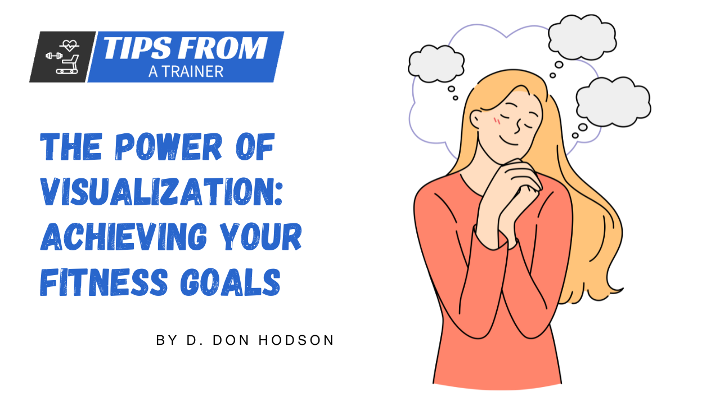Introduction
When it comes to achieving fitness goals, the power of visualization is often overlooked. Many people focus solely on physical training and nutrition, neglecting the mental aspect of their fitness journey. However, the mind plays a crucial role in shaping our actions, motivations, and ultimately, our success.
Visualization is a mental technique that harnesses the power of the mind to create vivid mental images of desired outcomes, enabling individuals to better align their actions with their goals.
Table of Contents
Introduction
Understanding Visualization
What is Visualization?
The Science behind Visualization
Benefits of Visualization for Fitness Goals
Incorporating Visualization into Your Fitness Routine
Setting Clear Goals
Creating a Visualization Practice
Designing Effective Visualizations
Integrating Visualization Techniques with Physical Training
Pre-Workout Visualization
Mid-Workout Visualization
Post-Workout Visualization
Tips for Maximizing the Power of Visualization
Consistency is Key
Maintain Belief and Positivity
Adapt and Evolve
Overcoming Challenges
Conclusion
Additional Resources

Understanding Visualization
What is Visualization?
Visualization is a powerful mental technique that involves creating detailed and vivid mental images in the mind's eye. It is the process of consciously using our imagination to simulate experiences or scenarios related to our goals. By engaging in visualization, we tap into the power of our subconscious mind, which cannot distinguish between real and imagined experiences. This means that when we vividly imagine ourselves achieving our fitness goals, our subconscious mind accepts those images as real, which in turn influences our beliefs, attitudes, and actions.
Engaging the Mind and Body in the Pursuit of Goals
Visualization goes beyond daydreaming or wishful thinking. It is an active and deliberate mental practice that engages both the mind and the body. When we visualize our fitness goals, we not only see ourselves achieving them but also immerse ourselves in the experience, engaging our senses, emotions, and physical sensations. This engagement creates a powerful mind-body connection, enhancing our motivation and determination to turn our visions into reality.
The Role of the Subconscious Mind in Visualization
Our subconscious mind is a vast reservoir of beliefs, memories, and habits that shape our thoughts, feelings, and behaviors. Visualization taps into this subconscious realm, allowing us to reprogram limiting beliefs and replace them with empowering ones. When we consistently visualize our fitness goals with conviction and emotion, we create new neural pathways in the brain, strengthening the connections associated with positive thoughts and behaviors. Over time, this rewiring of the brain can lead to a natural alignment between our conscious intentions and subconscious beliefs, making it easier to take consistent action towards our fitness goals.
The Science behind Visualization
While visualization has long been practiced and championed by athletes, artists, and performers, its effectiveness is now supported by scientific research.
Scientific Studies Supporting Visualization
Numerous studies have shown the benefits of visualization in various fields, including sports and physical performance. For example, a study published in the Journal of Sports Sciences found that basketball players who practiced visualization showed significant improvements in free-throw accuracy compared to those who did not. Other research has demonstrated the positive impact of visualization on strength gains, motor skill development, and overall performance.
Neuroplasticity and Visualization
Neuroplasticity is the brain's ability to reorganize and adapt its structure and function in response to experiences, thoughts, and emotions. Visualization has been found to stimulate neuroplastic changes in the brain, creating new neural connections and strengthening existing ones. When we vividly imagine ourselves performing exercises, improving technique, and achieving fitness milestones, our brain undergoes changes that support those desired outcomes. This rewiring of the brain enhances motor learning, coordination, and muscle activation, leading to improved physical performance.
Motivation, Focus, and Performance
Visualization has a profound impact on motivation, focus, and overall performance. When we consistently visualize ourselves reaching our fitness goals, we strengthen our motivation by reinforcing the positive emotions associated with success. Visualization also helps us maintain focus and concentration during workouts, reducing distractions and improving mental clarity. By mentally rehearsing our exercises, we enhance motor imagery, which has been shown to improve physical performance. This mental rehearsal primes our muscles and nervous system, making our movements more efficient and effective.
Benefits of Visualization for Fitness Goals
Visualization offers numerous benefits for individuals pursuing fitness goals.
Motivation and Commitment
One of the key benefits of visualization is its ability to enhance motivation and commitment. By regularly visualizing the achievement of our fitness goals, we tap into our deepest desires and aspirations, fueling our motivation to stay dedicated to our fitness routines. Visualization helps us maintain focus on our long-term objectives, even when faced with obstacles or setbacks. It strengthens our commitment by reinforcing our belief in our abilities and reminding us of the rewards awaiting us upon successful goal attainment.
Confidence and Self-Belief
Visualization plays a pivotal role in building confidence and self-belief. By repeatedly visualizing successful outcomes, we create a mental blueprint of achievement in our minds. This mental rehearsal instills confidence by familiarizing us with the process and outcome of our goals, reducing anxiety and self-doubt. As we vividly imagine ourselves overcoming challenges, pushing our limits, and achieving milestones, our belief in our own capabilities grows stronger. This increased self-belief translates into greater self-assurance during workouts and a willingness to take on new challenges.
Technique, Endurance, and Performance Improvement
Visualization can significantly improve technique, endurance, and overall performance. When we visualize ourselves performing exercises with precision and proper form, our brain processes the information as if we were physically practicing. This mental practice reinforces the neural pathways associated with correct movement patterns, enhancing muscle memory and motor learning. Visualization can also be used to increase endurance by imagining ourselves pushing through fatigue and maintaining a steady pace during workouts. By mentally rehearsing successful performance, we prime our minds and bodies for optimal execution, leading to improved overall performance.
Incorporating Visualization into Your Fitness Routine
Setting Clear Goals
Setting clear and specific goals is essential for effective visualization. When your goals are well-defined, you can create a clear mental image of what you want to achieve. Follow the SMART goal framework, which stands for Specific, Measurable, Achievable, Relevant, and Time-bound. For example, instead of setting a vague goal like "get in shape," a SMART goal would be "lose 10 pounds in three months by following a consistent exercise and nutrition plan."
When visualizing your fitness goals, imagine yourself in the specific scenarios associated with achieving those goals. See yourself performing exercises correctly, feeling energized during workouts, and enjoying the physical and mental benefits of your progress. Create a mental movie with vivid details to make your visualization more effective.
Creating a Visualization Practice
To incorporate visualization into your fitness routine, it's important to establish a regular practice. Consider the following tips:
Ideal Environment, Timing, and Duration
Find a quiet and comfortable space where you can relax without distractions. Ideally, choose a time of day when you're most focused and can dedicate uninterrupted time to visualization. Start with short sessions, around 5 to 10 minutes, and gradually increase the duration as you become more comfortable with the practice.
Relaxation Techniques, Deep Breathing, and Focus
Before starting your visualization practice, engage in relaxation techniques such as deep breathing or progressive muscle relaxation to calm your mind and body. Deep, diaphragmatic breathing can help induce a state of relaxation and focus. As you begin visualizing, maintain your focus on the mental images, sensations, and emotions associated with your fitness goals. If your mind wanders, gently bring your attention back to the visualization.
Designing Effective Visualizations
To make your visualizations more effective, consider the following strategies:
Multisensory Visualization
Engage as many senses as possible during your visualization practice. In addition to visualizing the scenes, vividly imagine the sounds, smells, and tactile sensations associated with your fitness goals. For example, if your goal is to run a marathon, visualize the sound of your footsteps, the feeling of sweat on your skin, and the exhilaration of crossing the finish line.
Positive Affirmations and Self-Talk
Incorporate positive affirmations and self-talk into your visualization sessions. Use empowering statements and words to reinforce your belief in your abilities. For example, repeat affirmations such as "I am strong, capable, and resilient" or "I have the discipline and determination to achieve my fitness goals." This positive self-talk helps shape your mindset and cultivates a positive attitude towards your fitness journey.
Integrating Visualization Techniques with Physical Training
Pre-Workout Visualization
Pre-workout visualization can be a powerful tool to mentally prepare yourself for workouts. Before heading to the gym or starting your exercise routine, take a few moments to visualize your upcoming session. Picture yourself going through a dynamic warm-up routine, feeling energized and focused. Visualize yourself executing exercises with proper form, experiencing the burn in your muscles, and pushing through any challenges that may arise. Imagine yourself reaching your peak performance and feeling a sense of accomplishment.
Mid-Workout Visualization
During your workouts, you can continue to leverage visualization techniques to enhance your performance. When faced with a challenging set or fatigue, take a moment to visualize yourself successfully completing the exercise. Imagine the feeling of strength and determination surging through your body. Visualize yourself maintaining proper form, pushing through any discomfort, and finishing strong. This mid-workout visualization can provide a mental boost and help you stay focused and motivated throughout your training session.
Post-Workout Visualization
Post-workout visualization is valuable for recovery and progress. After completing your workout, take time to visualize your body healing, recovering, and becoming stronger. Imagine the muscles repairing and growing, envisioning your progress towards your fitness goals. Use this visualization as a moment of relaxation and rejuvenation, allowing your mind and body to recharge after the physical exertion. Additionally, reflect on your workout and mentally celebrate your achievements, no matter how small they may seem. This positive reflection reinforces your sense of accomplishment and builds confidence for future workouts.
Tips for Maximizing the Power of Visualization
To maximize the effectiveness of visualization for achieving fitness goals, consider the following tips:
Consistency is Key
Consistency is crucial when it comes to visualization. Incorporate visualization into your daily routine and make it a habit. Consistent practice strengthens the neural connections associated with your goals and reinforces the positive beliefs and attitudes necessary for success.
Maintain Belief and Positivity
Believe in the power of visualization and maintain a positive mindset. Trust that your visualization practice can create real-world results. Embrace a positive attitude and focus on the possibilities rather than potential obstacles. Visualize success with conviction and optimism.
Adapt and Evolve
As you progress on your fitness journey, adapt your visualization practice to reflect your changing goals and aspirations. As you achieve smaller milestones, set new goals and adjust your visualizations accordingly. Continually challenge yourself and expand your mental imagery to encompass greater levels of success.
Overcoming Challenges
Acknowledge that challenges are a part of the journey. When faced with setbacks or obstacles, use visualization as a tool to overcome them. Visualize yourself finding solutions, persevering, and emerging stronger on the other side. By visualizing resilience and determination, you cultivate the mindset needed to overcome challenges and stay committed to your goals.
Conclusion
Visualization is a powerful tool for achieving fitness goals by harnessing the transformative power of the mind. By creating vivid mental images and engaging the subconscious mind, visualization aligns our thoughts, beliefs, and actions with our desired outcomes. Scientific research supports the effectiveness of visualization in improving motivation, focus, technique, and overall performance.
Incorporating visualization into your fitness routine can enhance your motivation, boost self-confidence, and improve your ability to overcome obstacles. By setting clear goals, creating a visualization practice, and integrating visualization techniques with physical training, you can unlock the full potential of visualization in achieving your fitness goals.
Remember, the power of visualization lies in its consistent practice and belief in its effectiveness. By incorporating visualization into your fitness routine, you tap into a powerful mental tool that can accelerate your progress and propel you toward your desired fitness outcomes.
Additional Resources
For further exploration of visualization and goal achievement in fitness, here are some recommended books, articles, and resources:
1. "The Champion's Mind: How Great Athletes Think, Train, and Thrive" by Jim Afremow
2. "Mind Gym: An Athlete's Guide to Inner Excellence" by Gary Mack
3. "The Power of Positive Thinking" by Norman Vincent Peale
4. "Creative Visualization: Use the Power of Your Imagination to Create What You Want in Your Life" by Shakti Gawain

Don Hodson, Certified Personal Trainer
I'm Don, an ACE-certified personal trainer and the founder of Tips From A Trainer. With my passion for fitness and years of experience, I've helped countless individuals transform their physiques!
Having personally overcome weight challenges throughout my life, I understand the struggle. Through consistency, exercise, and a balanced diet, I have managed to stay in shape and I want to share my message with the world!
The fitness industry is fraught with misconceptions and deceptive practices, which is why I am committed to providing you with the truth.
- My Site: www.Don-Hodson.com
- My Company: www.ConnectedAgeMarketing.com

The Power of Visualization